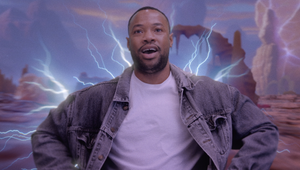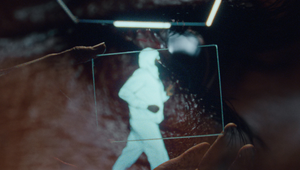
Martina Magorin Borg on Sharpening your Directorial Voice

Martina Magorin Borg, repped by Giants & Toys in Sweden and Golden LA in the US, is a Stockholm-born, LA-based filmmaker with roots in advertising and social creative who transitioned to full-time directing four years ago. Commercials for brands such as H&M, Facebook, and Netflix were the first projects that launched Martina into her directing career, as well as her short film ‘Night All Day’ and the recently-completed ‘Preach’, an eight-episode mini series for UR [the Swedish Public Broadcaster].
Growing up in Stockholm, she spent a large portion of her childhood as a constant revolving door of films, watching and talking about film with her father, who at the time was a critic. Implicitly developing a critical eye from an early age with his help, Martina also started finding it increasingly difficult to enjoy cinema beyond critical dissection. “But there’s no question that it fundamentally shaped my understanding of visual storytelling and led me to my career today,” she rounds off.
Regardless of the planting of the subliminal seed, Martina’s path to filmmaking was circuitous. “I went to writing school in Sweden and then worked in the creative department at several ad agencies in Europe. Eventually, I found myself at an agency where the line between creative direction and directing was kind of blurred,” she says. Where she could take over more directorial responsibilities, Martina blossomed into her best version and realised she loved being in the eye of the storm.
“The thing I wish I’d known then, however,” she adds, “is that everything hangs on the energy that you, the director, bring to the set. It’s easy to assume you have to act like you’re ‘in command’, but I quickly realised that when I was more relaxed and playful, the rest of the crew and actors did their best work.”
While she knew her passion laid in directing and filmmaking, putting her work out there at the start was nerve-wracking. “It still is,” she admits. “You always feel it could be better and there’s this temptation to hold onto it longer and keep polishing it.” She explains this is the case a lot of the time with personal projects, as there is no client feedback to set clear boundaries, so nobody is there to tell you when you’ve crossed the threshold “from okay to good, to great”. Another lesson to be learned here, as Martina puts it, is that it will never be perfect - “At a certain point, I just have to rip off the band-aid.”
One thing, however, hasn’t changed since the start - Martina’s goal back then, and still today, is to “sharpen [her] own voice.” Agency work usually encourages creatives and directors to mimic the voice of a brand, but as a director, Martina knows that that’s not what is helpful to the brand or the storytelling more broadly. “You have to be able to make things that no one else can make, even if you’re shepherding someone else’s story. That’s the never-ending journey I’m on.”
The line between your own voice and the voice of those you represent can also get blurry at times, especially for people like Martina, who have their backgrounds in agencies. During the start of her career, she began working heavily with brands such as Adidas, YouTube and Nike, so when she made the transition to full-time directing she already knew what she was doing. But there were still some learning curves. “In the beginning, I admit I tried to roll my sleeves up a little too much and re-develop the creative. But now I really love the fact that I get to come in and add those last small but critical tweaks to lift the work even further. It’s like being handed a puzzle that’s mostly complete, and I get to put in those last few pieces to make it whole.”
Going back to sharpening her directorial voice, Martina looks at the influences she’s had through her life and the themes that draw her in most. “A lot of the stories I’m interested in telling revolve around young people. I’m intrigued by how they capture and narrate their own stories, especially in this hyper-digital age. When I incorporate these elements into my work, I find it adds authenticity and believability because it reflects the way they experience their own realities.”
At the same time, though, she wants to include some of the grander film tropes she picked up on as a kid. “I think that a mixed approach adds visual tension and delivers something that’s the best of both worlds. I guess some brands might be drawn to my specific style, whereas others may be looking for me to help them reframe their existing style in a new way.”
Both youthful themes and grand tropes can be seen in ‘Preach’, the eight-episode mini series Martina created revolving around faith and anxiety in the ‘land of dreams’, Los Angeles. The inspiration for the series came from Martina’s own story of moving to the US and coming to understand the major role that religion plays there compared to Sweden, or Europe as a whole. “Add to the youth involvement with organisations like Hillsong or City Church, I was blown away, frankly, and so I kept thinking about how a young person from Sweden, who is dealing perhaps with similar existential anxieties, would react to the American tendency toward worship. Would it be off-putting to them, or could it be a salvation to them? I made the doc because I wanted to find out.”
‘Preach’ was not only Martina’s moment to explore themes that interested her, but to also view her own story through a more removed lens. The majority of her professional career has been international, living and working between Amsterdam, London and now Los Angeles. As she puts it herself, she is neither an American director, nor a traditionally Swedish one.
One difference between America and Europe Martina has noticed so far is the pure scale of the projects - everything is bigger in the States. “There is a lot of hyper-specialisation as well - everyone has a specific role, wears one hat and they’re incredibly good at what they do. In contrast, Sweden productions tend to involve people wearing multiple hats. That brings a strong sense of collaboration, a spirit to ‘figure it out together’, whereas in the US, you get to work with people who are masters at their craft.”
Martina explains that Sweden pushes her to think differently, and go out of the box with the resources she has. In the American market, on the other hand, she is able to push her own creative boundaries and expand the vision to more ambitious territories. “The best of both worlds,” she says.
Of course, the stylistic differences can’t be forgotten either. Martina’s view is that the US has a more direct approach to storytelling, versus the more covert one in Sweden. “This is a generalisation but in commercial work, you might describe that difference as the ‘hard sell’ and the ‘soft sell’.” And while both have their pros, Martina admits to be more naturally inclined to the latter, so when working for the American market, she has had to jump some hurdles to become more direct. “And conversely, I try to occasionally bring a more direct approach into the Swedish market because it can be perceived as refreshing and unique.”
Some things, however, don’t change - regardless of location - and a lot of them revolve around how a director has to behave on set. Communication is key, so Martina says that on the ground she spends most of her time speaking to her team leads - DP, production designer, producer. “Those are the core relationships that form the heartbeat of the whole thing,” she says. But that doesn’t mean that they are the only important ones - to her, every relationship on set is crucial, from lead actor to the first-time assistant.
She continues, “Everyone’s contributing something and without them, the entire machine would grind to a halt. That’s why I try my best to make sure everyone feels seen and valued. I want them to know that they’re an integral part of the process. That also helps to ease pressure on the folks who are front and centre, whether they’re in front of the camera or taking the lead behind the scenes. It helps them understand it’s not all on them, we’re all in this together, and we’re all responsible for making something great.” This is something she has learned from her Swedish roots and carries with her everywhere.
Bringing it back a little, Martina’s pre-production process is more varied and instinctual. She tends to chase the ‘Aha!’ moment until she knows she’s hit something good. The challenge to her is to do the hard work of nailing down all the details, so that spontaneity on set is allowed and encouraged. “The tighter your pre-production process is, the more space you will have to be flexible when you’re shooting,” she says.
“I see a lot of the pre-production - casting, callbacks, camera tests, etc. - as rehearsal time. With each step, you bring the piece to life. It’s like this slow reveal, it begins to take shape, and then on set and in post, you get to make your finished piece.”
So, her spontaneity and free-spirit on set, grouped with her rigorous pre-production process and critically trained eye, Martina arrives at the three words that describe her filmmaking: “Playful, authentic, with a pinch of irreverence.”
Those all come through in her first stab at pure narrative storytelling in ‘Oh Boys’. Intrigued by gender dynamics and inspired by her partner’s writing on masculinity, Martina embarked on an exploration of the machismo in a way that wasn’t too hectoring or preachy. “More like a cheeky twist on expectations,” she says.
The cinematic style mirrored the theme - beginning with static, aggressive camera work, the piece slowly transitions into more fluid movements. “By the end it hints at a softer, or more ‘feminine’ style. But if I’m real with you, I was just trying to create something visually and emotionally interesting. A mix of beauty and grit. It was another way for me to try to sharpen my voice and tell a story that others might enjoy.”
Another exercise in voice-sharpening was her first documentary work called ‘Night All Day’, a film following three lives that exist in their own unique ways above the Arctic Circle where for three months of the year, the sun never shines. Shot in Northern Scandinavia, the film is an ode to Martina’s “naive ambition” at the start of her filmmaking career. “It suffices to say the filming conditions were intense,” she reflects. “I got to work with my friend - the very talented DP Axel Pettersson. But we shot in sub-zero temperatures of -20 Fahrenheit, so we had to pack our film cameras with heating bags to prevent the batteries from constantly dying.”
Martina even ended up bringing her younger sister along for the project to do sound, but regardless of the dedicated crew, they had to keep the focus on both the storytelling and not getting hypothermia. “Still, being up there and seeing the Northern Lights was unforgettable. I’d do it again in a heartbeat,” she adds.
Looking ahead at the decade to come, Martina says she wants to keep pushing her boundaries as she always has, and learn all the new ways to express that voice within. “I want to tell the stories I’m passionate about in more and more elaborate ways. And to do that, I need to keep working with the kind of people who push me to step outside my comfort zone, keep learning, and constantly level up.”












